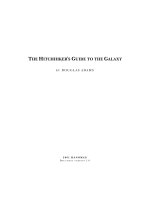Ace organic chemistry i the EASY guide to ace organic chemistry i (organic chemistry study guide, organic chemistry review, concepts, reaction mechanisms and summaries)
Bạn đang xem bản rút gọn của tài liệu. Xem và tải ngay bản đầy đủ của tài liệu tại đây (3.52 MB, 169 trang )
ACE ORGANIC
CHEMISTRY I
(THE EASY GUIDE
TO
ACE ORGANIC CHEMISTRY I)
BY: DR. HOLDEN HEMSWORTH
Copyright © 2015 by Holden Hemsworth
All rights reserved. No part of this publication may be reproduced, distributed, or transmitted in any
form or by any means, including photocopying, recording, or other electronic or mechanical methods,
without the prior written permission of the publisher, except in the case of brief quotations embodied in
critical reviews and certain other noncommercial uses permitted by copyright law.
DISCLAIMER
Chemistry, like any field of science, is continuously changing and
new information continues to be discovered. The author and publisher have
reviewed all information in this book with resources believed to be reliable
and accurate and have made every effort to provide information that is up to
date and correct at the time of publication. Despite our best efforts we cannot
guarantee that the information contained herein is complete or fully accurate
due to the possibility of the discovery of contradictory information in the
future and any human error on part of the author, publisher, and any other
party involved in the production of this work. The author, publisher, and all
other parties involved in this work disclaim all responsibility from any errors
contained within this work and from any results that arise from the use of this
information. Readers are encouraged to check all information in this book
with institutional guidelines, other sources, and up to date information.
MCAT® is a registered trademark of the Association of American
Medical Colleges and holds no affiliation with this book.
The information contained in this book is provided for general
information purposes only and does not constitute medical, legal or
other professional advice on any subject matter. The author or publisher
of this book does not accept any responsibility for any loss which may arise
from reliance on information contained within this book or on any associated
websites or blogs.
WHY I CREATED THIS STUDY GUIDE
Organic Chemistry is typically taught over two semesters in college and these
courses tend to be some of the hardest for students as they require a lot of
memorization. In this book, I try to breakdown the content covered in the
typical first semester of an Organic Chemistry course for easy understanding
and to point out the most important subject matter that students are likely to
encounter in hopes of making the material more palatable. This book is meant
to be a supplemental resource to lecture notes and textbooks, to boost your
learning, and to go hand in hand with your studying!
I am committed to providing my readers with books that contain concise and
accurate information and I am committed to providing them tremendous
value for their time and money.
Best regards,
Dr. Holden Hemsworth
Your reviews greatly help reach more students. If you find this book
helpful, please click below to leave a review on Amazon or to share the
book on Facebook. Nothing helps more than a few kind words.
TABLE OF CONTENTS
CHAPTER 1: Revisiting General Chemistry
CHAPTER 2: Alkanes and Cycloalkanes
CHAPTER 3: Stereoisomerism and Chirality
CHAPTER 4: Acids and Bases
CHAPTER 5: Alkenes
CHAPTER 6: Reactions of Alkenes
CHAPTER 7: Alkynes and Reactions of Alkynes
CHAPTER 8: Haloalkanes and Radical Reactions
CHAPTER 9: Nucleophilic Substitution and β-Elimination
CHAPTER 10: Alcohols and their Reactions
CHAPTER 11: Ethers and Epoxides
CHAPTER 1: REVISITING GENERAL
CHEMISTRY
Organic Chemistry
Organic chemistry is the branch of chemistry that specializes in studying
carbon compounds. Organic compounds contain both carbon and hydrogen
atoms, while inorganic compounds typically lack carbon.
Carbon
Relatively small atom
Capable of forming single, double, and triple bonds
Electronegativity = 2.55
Intermediate electronegativity
Forms strong bonds with C (carbon), H (hydrogen), O (oxygen), N
(nitrogen)
Also with some metals
Has 4 valence electrons
To fill its outer shell, it typically forms four covalent
bonds
Carbon is capable of making large and complex
molecules because it is capable of branching off into four
directions
Covalent bonds link carbon atoms together into long chains
Form the skeletal framework for organic molecules
Hydrocarbons are molecules containing only carbon and hydrogen
Examples: methane (CH4), ethane (C2H6), propane
(C3H8)
Hydrocarbon chains are hydrophobic because they
consist of nonpolar bonds
Electron Orbitals
Electrons orbit the nucleus of an atom in “orbitals” of increasing energy
levels, or shells. Orbitals are mathematical functions that describe the wavelike behavior of an electron in a molecule (calculates the probability of where
you might find an electron).
Electrons in shells closest to the nucleus have the lowest potential
energy
Conversely, shells farther from the nucleus have higher
potential energy
Shell Model of a Neon Atom:
Orbitals aren’t necessarily circular as represented in the shell
model
In reality, orbitals are “clouds” of various shapes
Each orbital can only hold a limited number of electrons
An atom can have multiple orbitals of different shapes
Electrons may move from one energy level to another
Happens when they gain or lose energy equal to the
difference in potential energy between energy levels
First energy level:
One spherical s orbital (1s orbital)
Holds up to two electrons
Second energy level
One spherical s orbital (2s orbital)
Three dumbbell-shaped p orbitals (2px, 2py, 2pz orbitals)
Higher energy levels
Contain s and p orbitals
Contain other orbitals with more complex shapes
Orbital Shapes (s, p, d, f) Top to Bottom:
Electron Configuration
The electron configuration of an atom refers to the particular distribution of
electrons among the available sub shells in that atom.
Electronic configuration notation lists subshell symbols (s, p, d, f)
sequentially with a superscript to indicate the number of electrons
in that subshell
Example: Carbon
Atomic Number: 6
Number of electrons in a neutral carbon atom: 6
Number of electrons for a neutral atom
is the same as its atomic number
2 electrons in the “1s” sub shell
2 electrons in the “2s” sub shell
2 electrons in the “2p” sub shell
Electron Configuration: 1s22s22p2
Configurations can become quite complex as atomic number
increases
To remedy this, a condensed form of the configuration is
often used which utilizes electron configurations of
noble gases
Noble gases have the maximum number of
electrons possible in their outer shell
Makes them very unreactive
The noble gases are: Helium, Neon, Argon,
Krypton, Xenon, and Radon
Table of Condensed Electronic Configuration Examples:
[X] represents the electron configuration of the nearest
noble gas that appears before the element of interest on
the periodic table
Keep in mind that you have to adjust the number of electrons and
thus the electron configuration for cations and anions of an
element
Energy-level Diagrams
Energy-level diagrams are notations used to show how the orbitals
of a sub shell are occupied by electrons
Each group of orbitals is labeled by its sub shell notation
(s, p, d, f)
Electrons are represented by arrows
Energy-level Diagram for Carbon:
Lewis Dot Structures
Lewis Dot Structure of Carbon:
Symbol of the element represents the nucleus and all the electrons
in the inner shells
Dots represent electrons in the valence shell
Valence shell – outermost electron shell of an
atom that is occupied with electrons
Valence electrons – electrons in the valence
shell
These are the electrons primarily
involved in chemical bonding and
chemical reactions
Bonding electron pairs are represented by either two dots
or a dash
Lewis Electron-dot Formula Example:
Rules for Forming Lewis Structures
Calculate the number of valence electrons for the
molecule
Group # for each atom (1-8)
Gives valence electron number for each
atom
Add all numbers up
Add the charge of any anions
Example: an anion with a -2 charge has
2 extra electrons, you would add 2 to
the total count
Subtract the charge of any cations
Example: a cation with a +3 charge
lacks 3 electrons, you would subtract 3
from the total count
Place the atom with the lowest group number and lowest
electronegativity as the central atom
Arrange the other elements around the central atom
Distribute electrons to atoms surrounding the central
atom to satisfy the octet rule for each atom
Distribute the remaining electrons as pairs to the central
atom
If the central atom is deficient in electrons, complete the
octet for it by forming double bonds or possibly a triple
bond
Ions
Ions are charged atoms or molecules. Ions are formed when atoms or groups
of atoms gain or lose valence electrons.
Monatomic ion – single atom with more or less electrons than the
number of electrons in the atom’s neutral state
Polyatomic ions – group of atoms with excess or deficient number
of electrons
Anion – negatively charged ion
Cation – positively charged ion
Ionic compounds – association of a cation and an anion
Electronegativity and Ions
Electronegativity is the measure of an atom’s ability of to draw bonding
electrons to itself in a molecule.
Electronegativity tends to increase from the lower-left corner to
the upper-right corner of the periodic table
Electronegativity Trend:
Types of Bonds
Covalent Bonds
Two atoms share valence electrons
Indicates that atomic orbitals are overlapping
Overlapping requires proximity and orientation
Two Types
Non-polar covalent bond – electrons shared equally
between atoms
Electronegativity of the two atoms is about the
same
Typically electronegativity difference between
the two atoms has to be less than 0.5 for nonpolar bonds
Electronegativity – an atom’s ability to attract
and hold on to electrons, represented by a
number
Polar covalent bonds – electrons shared
disproportionately between atoms
Electronegativity between the two atoms is
different by a greater degree than 0.5 but less
than 2.0
Polarity can be represented using δ+ and δδ+ represents the positive end
δ- represents the negative end
Polarity can also be represented by an arrow
with a plus sign tail
Tip of the arrow represents the negative
end
Plus sign tail represents the positive
end
Number of shared pairs
Single bond - one shared pair
Double bond – two shared pair
Triple bond – three shared pairs
Ionic Bonds
Electrons are transferred, not shared between atoms
An atom with high electronegativity will take an electron from an
atom with low electronegativity
Typically, difference in electronegativity is more than
2.0
Ion – charged atom or molecule
Anion – negatively charged ion
Cation – positively charged ion
Hydrogen Bonds
Attractive force between a hydrogen attached to an electronegative
atom of one molecule to a hydrogen attached to an electronegative
atom of a different molecule
Electronegative atoms usually seen in molecules are O, N, and F
Van der Waals Forces
A general term used for the attraction of intermolecular forces between
molecules.
Dipole-dipole Interactions
Interaction between 2 polar groups
London Dispersion Forces
Interaction between 2 non-polar molecules
Small fluctuation in electronic distribution
Intermolecular Forces
Forces that act between neighboring particles (can be repulsive or
attractive).
Intermolecular bond strength ranking (strong to weak):
Covalent > ionic > hydrogen > van der Waals forces
Weaker bonds and forces are easily broken or overcome and also
re-formed
Makes them vital for the molecular dynamics of life
Shared electron pair simultaneously fills the outer level
of both atoms
Functional Groups
Functional groups are characteristic groups of atoms responsible for the
characteristic reactions of a particular compound.
Functional groups have specific chemical and physical properties
that are associated with them
Are commonly the chemically reactive regions within organic
compounds
Determine unique chemical properties of organic
molecules that they are a part of
Consistent properties in all compounds in which they
occur
Common Functional Groups
Hydroxyl group - consist of a hydrogen atom bonded to an oxygen
atom
Hydroxyl Group:
Polar group; oxygen and hydrogen bond is a polar
covalent bond
Organic compounds with hydroxyl groups are called
alcohols
Alcohol classification
Primary (1˚) – 1 carbon atom bonded to the
carbon bearing the hydroxyl group
Secondary (2˚) - 2 carbon atoms bonded to the
carbon bearing the hydroxyl group
Tertiary (3˚) - 3 carbon atoms bonded to the
carbon bearing the hydroxyl group
Amino group - consists of a nitrogen atom bonded to two
hydrogens and to the carbon skeleton
Amino Group:
Amines – consist of an amino group bonded to either
one, two, or three carbons (1˚, 2˚, or 3˚)
Carbonyl group - consists of a carbon atom double-bonded to
oxygen
Carbonyl Group:
Aldehyde – carbonyl group with a hydrogen attached to the carbon
Aldehyde Group:
Ketone – carbonyl group with no hydrogens attached to the carbon
Carboxyl group – consists of a carbon atom which is attached by a
double-bond to an oxygen and single-bonded to the oxygen of a
hydroxyl group
Group has acidic properties
Since it donates H+
Organic compounds with a carboxyl group are called
carboxylic acids
Carboxyl Group:
Ester – derivative of carboxylic acid, where the hydrogen bond is
replaced with a carbon bond
Amide (aka carboxylic acid) – derivative of carboxylic acid in
which the hydroxyl group (-OH) is replaced by an amine
Amide:
Sulfhydryl group - consists of an sulfur atom bonded to a hydrogen
Organic compounds with a sulfhydryl group are called
thiols
Sulfhydryl Group:
Phosphate group – consists of a phosphorous atom single bonded
to 4 oxygen atoms, and one of those oxygens is attached to the rest
of the molecule
Acidic properties (loses H+)
Organic phosphates are important part of cellular energy
storage and transfer
Phosphate Group:
Molecular Orbital Theory
As atoms approach each other and their atomic orbitals overlap,
molecular orbitals are formed
Only outer (valence) atomic orbitals interact enough to
form molecular orbitals
Combining atomic orbitals to form molecular orbitals involves
adding or subtracting atomic wave functions
Adding wave functions
Forms a bonding molecular orbital
Electron charge between nuclei is dispersed over a larger
area than in atomic orbitals
Molecular orbitals have lower energy than atomic
orbitals
Reduction in electron repulsion
Bonding molecular orbital is more stable than atomic
orbital
Subtracting Wave Functions
Forms an antibonding molecular orbital
Electrons do not shield one nuclei from the other
Results in increased nucleus-nucleus repulsion
Antibonding molecular orbitals have a higher energy
than the corresponding atom orbitals
When the antibonding orbital is occupied, the molecule
is less stable than when the orbital is not occupied
Molecular Orbitals of H2:
Hybrid Orbitals
Quantum mechanical calculations show that if specific
combinations of orbitals are mixed, “new” atomic orbitals are
formed
These new orbitals are called hybrid orbitals
Types of hybrid orbitals
Each type has a unique geometric arrangement
Hybrid orbitals are used to describe bonding that is obtained by
taking combinations of atomic orbitals of an isolated atom
Number of hybrid orbitals formed = number of atomic orbitals
combined
Steps for determining bonding description
Write the Lewis dot formula for the molecule
Then use the VSEPR theory to determine the
arrangement of electron pairs around the central atom
From the geometric arrangement, determine the
hybridization type
Assign valence electrons to the hybrid orbitals of the
central atom one at a time
Pair only when necessary
Form bonds to the central atom by overlapping singly
occupied orbitals of other atoms with the singly occupied
hybrid orbitals of the central atom
Multiple Bonds
Orbitals can overlap in two ways
Side to side
End to end
Two types of covalent bonds
Sigma bonds (C-C)
Formed from an overlap of one end of the
orbital to the end of another orbital
pi bonds (C=C)
Formed when orbitals overlap side to side
Creates two regions of electron density
One above and one below
Double bonds always consist of one sigma bond and one pi bond
Covalent Bonding of Carbon









